-
 E-mail
canye8654065@gmail.com
E-mail
canye8654065@gmail.com
-
 Call Us
0086 13641173523
Call Us
0086 13641173523
 E-mail
canye8654065@gmail.com
E-mail
canye8654065@gmail.com
 Call Us
0086 13641173523
Call Us
0086 13641173523
2020-05-20 15:21:25 XinHai Views:24661
Defination:Gold CIP process (carbon in pulp) is one of the gold cyanidation methods, which is the process of carbon adsorption of monovalent gold cyanide [KAu(CN)2] after cyanide leaching of gold-bearing materials.

CIP (carbon in pulp) gold extraction process is a method of adding activated carbon to the cyanide slurry, adsorbing the dissolved gold to the activated carbon, and extracting gold from the activated carbon. Gold CIP process eliminates the slurry washing and solid-liquid separation operations, directly uses granular activated carbon to absorb gold from pulp, and optimizes the traditional cyanidation gold extraction process, which simplifies the industrial production process, improves the leaching efficiency and reduces the production cost.
There are five main steps for gold CIP process: raw material preparation, agitation leaching and adsorption, gold-bearing carbon desorption, pregnant solution electrolysis and activated carbon recycling.
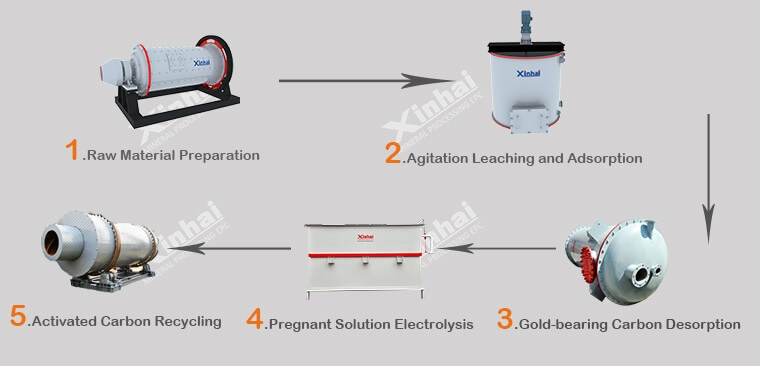
Gold-bearing materials are crushed and ground to the particle size suitable for cyanidation, generally -200 mesh account for 80-90%, and remove impurities such as wood chips. Then use the thickener to concentrate and dehydrate the slurry, increase the concentration of the slurry to 40-42%, and then carry out the leaching operation.
Add the cyanide slurry to the agitation adsorption tank (carbon slurry tank), which is the same as the conventional cyanidation method, generally 5 to 8 double impeller agitation leaching tanks. Lime and sodium cyanide are added to the tank, and compressed air is passed into the tank for leaching and adsorption. The activated carbon is added to the fully leaching slurry, and the activated carbon adsorbed the gold in the cyanide slurry and became the gold-bearing carbon. The leaching time is generally 24 hours to 48 hours. During the period, the first two tanks are used for preimpregnation, and the next four to six tanks are used for leaching and adsorption.
The process of removing gold from the gold-bearing carbon separated from the gold-removing slurry is called desorption. There are four methods for desorption currently:
(PS: In order to protect the environment, low-toxic environmental protection gold dressing agents are often used instead of sodium cyanide)
The main method of gold precipitation from the desorption solution is electrolysis. After desorption of gold-loaded carbon, high-grade pregnant solution containing gold up to 600 g / m3 can be obtained. Electrolyzing pregnant solution to obtain gold powder, smelting the gold powder to obtain gold ingot.
The activated carbon after desorption is first pickled with dilute sulfuric acid (nitric acid) to remove carbonate and other accumulations. After several times of return, thermal activation is required to restore the adsorption activity of the carbon.
1. Gold CIP method has almost no effect on the change of ore properties. Due to the high selectivity of carbon for the gold adsorption, when other secondary metals (copper and zinc) fluctuate, CIP method can be adapted as long as the cyanidation conditions are suitable.
2. Gold CIP method is not very sensitive to the problems in production, and there are very few operating parameters to be strictly controlled. It is easy to start and stop the CIP reactor.
3. The products obtained by gold CIP method are of high quality and can often be directly melted into ingots.
4. Since activated carbon always absorbs gold from the solution, the gold left in the lean solution is lower than the zinc powder replacement method, so the gold recovery rate of CIP method is high.
5. Gold CIP method is particularly suitable for gold-bearing oxidized ores that are rich in mud and difficult to settle and filter.
1.Gold CIP method has strict requirements on activated carbon. If the carbon is not strong enough, it will be broken in the adsorption process, which will cause the loss of gold with the broken carbon.
2.The process is more complicated and contains many process flows.
3.Gold CIP method is not suitable for gold ores with high silver content. Experts in the United States have tested that when the gold ore contains more than 30g/t of silver, it is not suitable for CIP method.
4.Since sodium cyanide cannot be recycled, it consumes a lot and pollutes the environment. (PS: In order to protect the environment, low-toxic environmental protection gold dressing agents are often used instead of sodium cyanide)
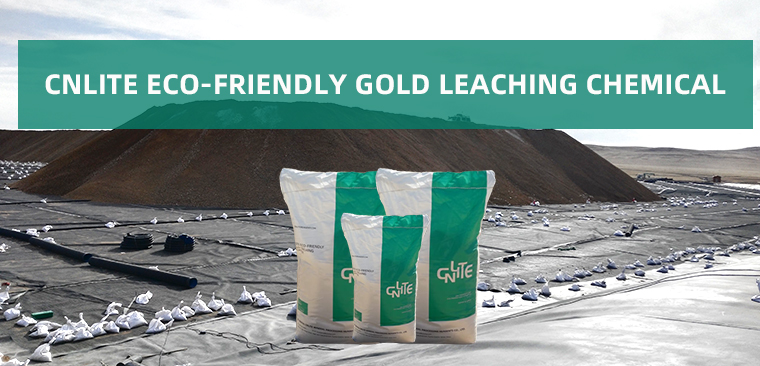
Gold CIP method is widely used, and is commonly used to extract gold from the following three types of gold mines:
The main characteristic of gold mines in the world at present is low grade. While the price of gold in the international market is rising. In order to make full use of resources, extensively recover the gold in waste residue or tailings, reduce costs, and improve the economic effect of minerals, it is feasible to use CIP method to process low-grade gold-bearing ores. For example, a gold processing plant in Canada uses CIP method to recover the gold from low-grade ore, which can save 20-30% of the investment compared with the conventional cyanidation method.
Many non-ferrous metals are associated with gold, which is generally recovered by flotation, gravity separation, amalgamation and cyanidation, but no satisfactory results can be obtained. Since using CIP gold extraction method, the gold recovery rate has been greatly improved. For example, a copper-lead-zinc processing plant in Russia recovered gold from lead flotation tailings (containing 0.15 mg / L of gold), increasing the gold recovery rate by 3%.
A gold processing plant in the UK directly extracted gold and silver from the slime using CIP method, and achieved good results. After the four-stage reflux adsorption of the slurry, the gold grade has dropped from 11.92 g / ton to 0.015 g / ton, the adsorption rate of activated carbon is 99.2%, the recovery rate of gold is 90-94%, which can save 25% of capital construction costs and 6% of production costs compared with the zinc powder replacement method.
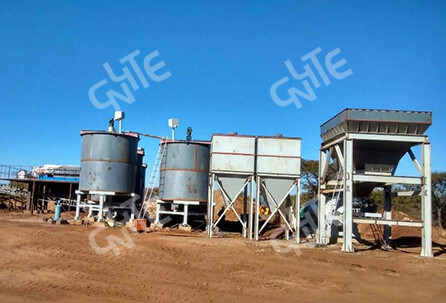
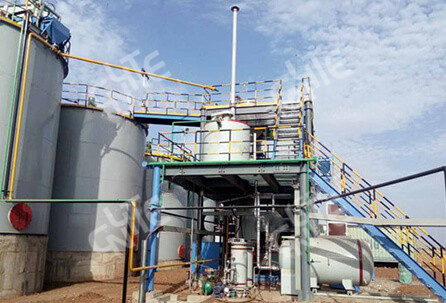
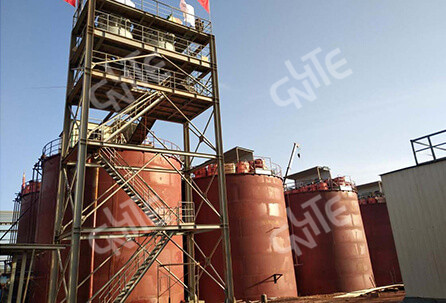
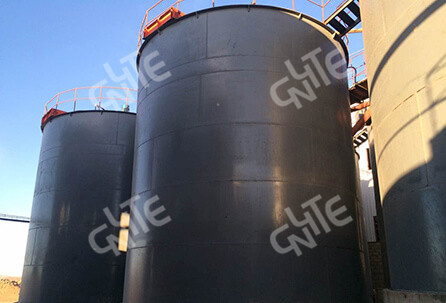
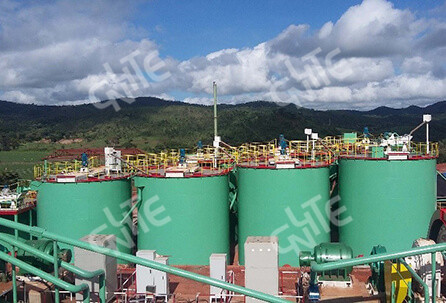
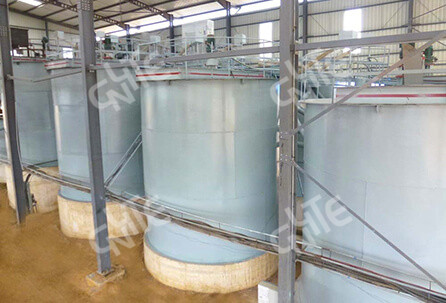
The above is the introduction of the steps, merits, demerits and application of gold CIP process. Gold CIP method has been widely used in the world, and has achieved good technical and economic effect. Before the actual production, you should choose the suitable gold extraction process according to the beneficiation experiment. You can also consult with professional manufacturers to maximize the benefits.
Please leave your message here! We will send detail technical info and quotation to you!